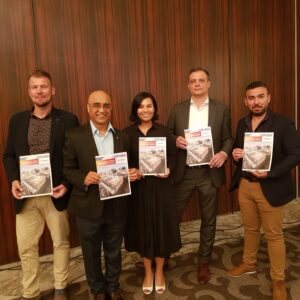Association hosts seminar on evaporative cooling
DUBAI, UAE, 24 November 2021: Eurovent Middle East on November 23 released the Cooling Tower Guidebook in a ceremony at Le Meridien Dubai Hotel & Conference Centre, with the objective of providing consultants, developers, building operators and investors a comprehensive reference into the cooling approach, including its application and benefits.
The ceremony was the culmination of two years of compiling the most essential information on evaporative cooling, Eurovent said.

Rafael Van Eijcken; Jai Kawrani; Nerissa Deoraj and Markus Lattner of Eurovent Middle East and Chukri Al Aani
The release was an opportunity for a technical seminar on the central theme of the book, with the authors presenting the salient features of evaporative cooling and participating in a question-and-answer session with members of the audience. The seminar was part of the Association’s HVACR Leadership Workshop programme.
Speaking first, Rafael Van Eijcken, General Manager – Middle East, Turkey & India, Baltimore Aircoil Middle East, gave an overview of the advantages of evaporative cooling by drawing a comparison between a 500 refrigerated ton (RT) air-cooled system and water-cooled system.
Whilst the electricity cost of operating an air-cooled system is USD 132,000, the cost in the case of a water-cooled system is USD 70,000, he pointed out. The water cost of operating a water-cooled system is USD 18,000 against nothing for an air-cooled system, he said.
This, he added, results in a total operating cost of USD 132,000 for an air-cooled system against a cost of USD 88,000 for a water-cooled system, which translates to a saving of USD 44,000 through operating a water-cooled system.
Speaking after him, Chukri Al Aani, Area Sales Manager (UAE, Qatar, Bahrain, Oman, Iraq and Turkey), Evaporative Cooling, SPX Cooling Technologies DMCC, highlighted the importance of certification of cooling towers. Elaborating on the Cooling Tower Institute (CTI), which he described as an independent third-party body that has established standard testing and performance analysis systems and procedures for cooling technologies, he spoke of how CTI and Eurovent have come together in partnership to advance the certification of cooling towers, as applicable to Europe, Middle East and India.
Speaking on the scope of certification, Al Aani said the general purpose is to encourage honest competition and to ensure correctly rated equipment in the marketplace.
Al Aani emphasised the presence of separate and specific certification programmes for each product type, and elaborated on the various tests, including Thermal Performance Test, as per CTI-ATC-105 Test Code; Equipment Operation, as per CTI-ATC-105 Test Code and Test Instrumentation, again as per CTI-ATC-105 Test Code.
He said the formula for success includes certified efficient products, optimised systems designs and professional installations.
Subsequent to the presentations, Van Eijcken, Al Aani and Jai Kawrani, Application Manager, Middle East & India, Baltimore Air Coil, participated in a question-and-answer session with members of the audience.
Answering a question on whether FRP is not a more specific solution to overcome rust, Al Aani said it depends on how a cooling tower is maintained. Weighing in, Van Eijcken said every material has its advantages and disadvantages. “For smaller capacity and shorter lifetime, you would, of course, prefer FRP,” he said. “For projects with larger lifetime, we go with other materials. Special coatings on GI can help overcome corrosion.”
Another member of the audience – Nishad Ahmed, CEO, Emcore – pointed out to the new Dubai Municipality regulation that prevents the use of potable water. “So you need to use TSE, or you should have an RO plant, which is an additional cost,” he said. “It costs USD 150,000 for an RO plant. For a small installation of 500 RT, it is not feasible to go with water-cooled system.”
Responding to this, Van Eijcken pointed out to different qualities of TSE and that the issue deserved a deeper study.
Copyright © 2006-2025 - CPI Industry. All rights reserved.